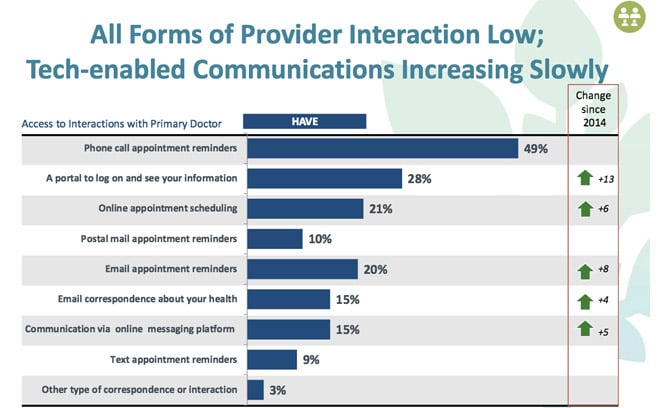A new Nielsen survey released by the Council of Accountable Physician Practices and the Bipartisan Policy Center shows that a majority of Americans are unaware of or don’t have access to the technology they could use to communicate with their doctors for better quality healthcare.
“Digital technologies can help overcome the barriers to accessing medical care, yet our survey shows that these tools are not available to most Americans,” said Robert Pearl, M.D., Chairman of the Council of Accountable Physician Practices and CEO of The Permanente Medical Group and the Mid-Atlantic Permanente Medical Group. “Healthcare providers must step up our adoption of these common-sense and available solutions if we are truly going to reform healthcare delivery.”
15% of American adults use email to communicate with their provider, and 14% have 24/7 access to medical advice.The survey polled more than 5,000 Americans ages 18 and over and looked at attitudes about and use of technology to inform, access and manage their medical care. Results showed that:
- 45% receive the traditional telephone appointment reminders;
- 21% have access to online appointment scheduling with their doctors;
- 15% use email to communicate with their provider;
- 14% have 24/7 access to medical advice;
- 9% receive reminders by text;
- 3% are able to send a photo of a medical condition over email;
- 2% have access to video visits.
The survey also highlighted four consumer groups who were most interested in gaining greater access to their doctors through digital technology: parents with children covered under their health plans, chronically ill patients, patients with acute conditions, and adults under 35 years of age.
While 36% of adults were interested in a 24/7 telephone line for medical advice, only 14% had used such a tool.Also those who don’t currently have access to their providers through electronic communications are most interested in ready access and online interactions: 36% preferred traditional telephone-based medical advice, while 34 and 36 percent, respectively, expressed interest in one-way engagement such as online appointment scheduling and online portals to access test results.
On the other hand, some technologies showed wider gaps between usage and interest than others among the people surveyed: while 36% of adults were interested in a 24/7 telephone line for medical advice, only 14% had used such a tool. Similarly, 28% were interested in text appointment reminders, yet only 9% had used them; and 26% were interested in submitting photos of conditions in preparation for phone or email consultations, yet only 3% had used such tools. Additionally, “virtual care” innovations, such as telemedicine, were found to be almost completely inaccessible to the average patient.
“Within these survey findings, it is important to note that the gaps between usage and interest levels may be an awareness issue. Consumers who expressed low interest levels in certain technologies may actually have limited awareness of available tools and the possible beneficial impact these applications may have,” noted Jennifer Colamonico, VP of Healthcare Insights and Chair at Strategic Health Perspectives, Nielsen Consumer Insights North America. “If consumers aren’t familiar with all the options, or cannot imagine how those options could enhance their healthcare experience, they place little value in such options. But consumer education can increase demand for and usage of these tools.”


